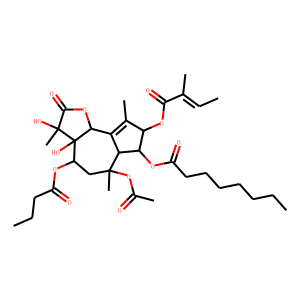| InChI | InChI=1S/C34H50O12/c1-9-12-13-14-15-17-24(37)43-28-26-25(20(5)27(28)44-30(38)19(4)11-3)29-34(41,33(8,40)31(39)45-29)22(42-23(36)16-10-2)18-32(26,7)46-21(6)35/h11,22,26-29,40-41H,9-10,12-18H2,1-8H3/b19-11-/t22-,26+,27-,28-,29-,32-,33+,34+/m0/s1 |
| Reference | 1. Curr Pharm Des. 2015;21(38):5501-17.
<br>
Thapsigargin, Origin, Chemistry, Structure-Activity Relationships and Prodrug
Development.
<br>
Quynh Doan NT, Christensen SB(1).
<br>
Author information: <br>
(1)Department of Drug Design and Pharmacology, Faculty of Health and Medical
Sciences University of Copenhagen, Universitetsparken 2, DK-2100 Copehagen O,
Denmark. [email protected].
<br>
Thapsigargin was originally isolated from the roots of the Mediterranean
umbelliferous plant Thapsia garganica in order to characterize the skin irritant
principle. Characteristic chemical properties and semi-syntheses are reviewed.
The biological activity was related to the subnanomolar affinity for the
sarco/endoplasmic reticulum calcium ATPase. Prolonged inhibition of the pump
afforded collapse of the calcium homeostasis and eventually apoptosis.
Structure-activity relationships enabled design of an equipotent analogue
containing a linker. Conjugation of the analogue containing the linker with
peptides, which only are substrates for either prostate specific antigen (PSA) or
prostate specific membrane antigen (PSMA) enabled design of prodrugs targeting a
number of cancer diseases including prostate cancer (G115) and hepatocellular
carcinoma (G202). Prodrug G202 has under the name of mipsagargin in phase II
clinical trials shown promising properties against hepatocellular carcinoma.
<br><br>
2. Ann N Y Acad Sci. 1998 Sep 16;853:195-206.
<br>
The sarcoplasmic reticulum Ca2+ pump: inhibition by thapsigargin and enhancement
by adenovirus-mediated gene transfer.
<br>
Inesi G(1), Wade R, Rogers T.
<br>
Author information: <br>
(1)Department of Biochemistry and Molecular Biology, University of Maryland
School of Medicine, Baltimore 21201, USA.
<br>
The role of the sarcoplasmic reticulum Ca2+ pump in the excitation-contraction
coupling of cardiac muscle fibers was evaluated in experiments on SR ATPase
inhibition with thapsigargin or, alternatively, on Ca2+ pump enhancement by SR
ATPase transgenic expression. We found that thapsigargin, a highly specific and
potent inhibitor of the SR ATPase, produces a strong reduction of cytosolic Ca2+
transient and contractile activation in neonatal rat myocytes, in the absence of
any other functional effect. On the other hand, Ca2+ pump enhancement by ATPase
transgenic expression affects dramatically Ca2+ transient and twitches, resulting
in shorter duration and more rapid decay rates. Of particular interest is gene
transfer mediated by recombinant adenovirus vectors under control of a
cell-specific promoter, resulting in transgenic expression of all myocytes in
culture, and no expression in fibroblasts.
<br><br>
3. Trends Pharmacol Sci. 1998 Apr;19(4):131-5.
<br>
A tool coming of age: thapsigargin as an inhibitor of sarco-endoplasmic reticulum
Ca(2+)-ATPases.
<br>
Treiman M(1), Caspersen C, Christensen SB.
<br>
Author information: <br>
(1)Department of Medical Physiology, Panum Institute, Copenhagen, Denmark.
<br>
Thapsigargin is the most widely used inhibitor of the ubiquitous
sarco-endoplasmic reticulum Ca(2+)-ATPases in mammalian cells. Over the past ten
years, this guaianolide compound of plant origin has become a popular tool in a
host of studies directed at elucidating the mechanisms of intracellular Ca2+
signalling. Its remarkable potency and selectivity have been instrumental in
widening our view of the function of intracellular Ca2+ stores to include such
key aspects as store-operated Ca2+ entry or the involvement of the stores in
protein synthesis or cell growth. In this article Marek Treiman, Casper Caspersen
and Søren Brøgger Christensen review the key pharmacological features of
thapsigargin action; they also discuss some of the ways in which its unique
properties have shown to be important for obtaining new insights into the biology
of Ca2+ stores, and how these properties might encompass a therapeutic potential.
In parallel, attention is drawn to some of the limitations and pitfalls
encountered when working with thapsigargin.
<br><br>
4. Biosci Rep. 1995 Oct;15(5):341-9.
<br>
Use of thapsigargin to study Ca2+ homeostasis in cardiac cells.
<br>
Rogers TB(1), Inesi G, Wade R, Lederer WJ.
<br>
Author information: <br>
(1)Department of Biological Chemistry, University of Maryland School of Medicine,
Baltimore, Maryland 21201, USA.
<br>
Several reports have documented that thapsigargin is a potent inhibitor of the SR
Ca2+ ATPase isolated from cardiac or skeletal muscle. We have characterized the
specificity of this agent in intact rat cardiac myocytes using cells maintained
in the whole cell voltage clamp configuration. We have shown that thapsigargin
decreases the magnitude of the Ca2+ transient and the twitch by about 80% while
it slows the decay rate for these responses. These changes were not accompanied
by any alterations in sarcolemmal currents or in the trigger Ca2+ generated by
the inward calcium current. Taken together these results reveal that the action
of thapsigargin is restricted to the SR Ca2+ ATPase in intact cardiac myocytes.
Furthermore, it is demonstrated unambiguously that SR intracellular Ca2+ stores
are an absolute requirement for the development of contractile tension in rat
heart myocytes. It is shown that thapsigargin is a valuable probe to examine the
importance of SR pools of Ca2+ and the role of the Ca2+ ATPase in intact myocytes
as well as in genetically altered heart cells.
<br>
|

